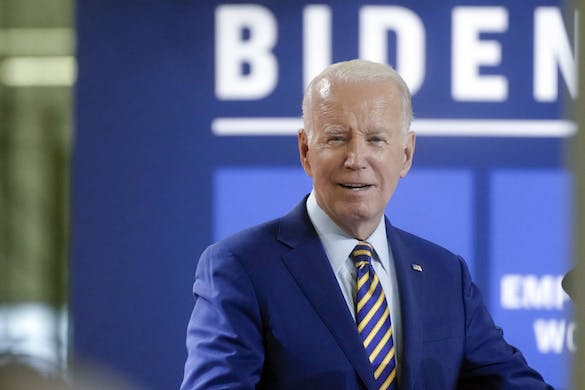It’s Biden Who Has the Inflation Problem
Trump years saw inflation safely under the Federal Reserve’s own target, while Bidenflation on average so far is running at thrice the Fed target.

The New York Times writes a piece called “Trump and Inflation” — and, of course, the gist of it is that Trump policies are going to push prices higher. Trouble is, there were no inflation numbers in the entire piece. Nothing. No numbers.
So, let me help them. Over the four years of President Trump’s first term, the consumer price index averaged 1.9 percent at an annual rate. That’s for the whole term. Less than the Fed’s target of 2 percent.
Oh, wait a minute! Wait, wait. The Fed likes to target something called the personal consumption deflator, or PCE. Under Mr. Trump, that came in at 1.6 percent at an annual rate.
So, if Trump policies held down inflation below the Federal Reserve target in his first term, and he pursues similar policies to rejuvenate the economy in a second term, why would there be higher inflation?
Oh, hang on a second! Isn’t it President Biden that has the inflation problem? That never entered into the New York Times story.
So Bidenflation, measured by the CPI, is 6 percent at an annual rate over his three years and the level of the consumer price index jumped 18 percent.
And, of course, individual prices — like groceries up 20 percent and gasoline up 25 percent — all that continues to plague middle-class working folks today.
Even though the overall inflation rate has finally eased from a 9 percent peak, prices remain very high.
By the way, during Mr. Trump’s term, consumer prices over the entire 4-year period increased only 7 percent. So, the New York Times is on pretty shaky ground on all this.
Here’s another point: drill, baby, drill. The average oil price during Mr. Trump’s term was $53 a barrel. Under Mr. Biden, it has been nearly $80.
Responding to high oil prices, mainly resulting from Mr. Biden’s war against fossil fuels, oil production recently, finally got back to 13 million barrels per day, which was the pre-pandemic peak under Mr. Trump.
Without the socialist Green New Deal and all kinds of limits on leasing and drilling, oil production should’ve gone up to at least 15 million barrels per day by now.
The point here, though, is that Mr. Trump’s unlocking the oil spigots, which he will resume in his second term, kept energy prices historically low, and these low energy prices permeate the entire economy.
In other words, New York Times: counter-inflation. And then there were Mr. Trump’s supply-side tax cuts for individuals, corporations, and small businesses. Those are inherently counter-inflationary, by providing new investment incentives to produce.
The increase in capital investment and productivity generated higher real wages for the whole workforce, but at the same time held down prices.
Mr. Trump will likely extend and even expand his successful pro-growth tax cut policy in a second term. And then there was Trumpian de-regulation.
For example, between 2017 and 2019, the Trump administration cut nearly eight regulations for every new significant regulation. Slashing costly and burdensome red tape helped unleash entrepreneurial production and new business formations.
That’s counter-inflationary. Another supply-side triumph. Even Mr. Trump’s push for tough, fair trade deals — including the increase in tariffs on China — had virtually no inflationary impact.
Despite all the screaming from conventional economists, the reality is that Chinese companies had to cut their margins in order to swallow tariff penalties on their unfair trading practices.
You know what? Other trade deals like USMCA, Japan, and South Korea? Well, they actually lowered tariffs, for the most part. Mr. Trump’s trade defense of American workers did not lead to higher inflation, as so many people guessed (wrong).
Finally, look for a second Trump administration to be much tougher on federal spending after watching Mr. Biden’s $6 trillion assault that is heading for $50 trillion in marketable federal debt.
Also, get ready for the Trump administration to push for executive budget impoundment authority, another weapon to cut spending.
What the New York Times seems to never understand is that supply-side policies that enhance production and investment — along with a shrinking role for government regulations — is inherently counter-inflationary.
As far as Mr. Trump is concerned: he did it once. And he’s raring to do it again.
From Mr. Kudlow’s broadcast on Fox Business Network.

